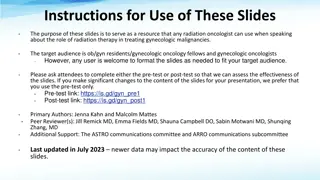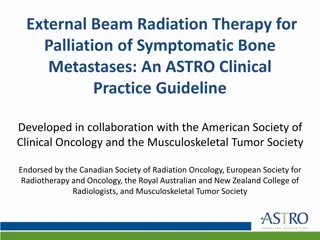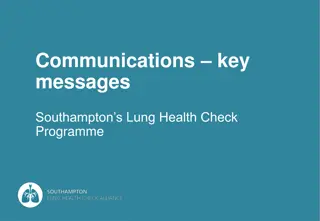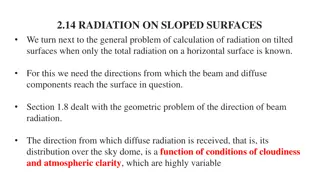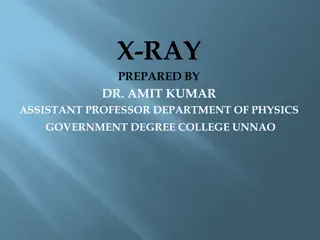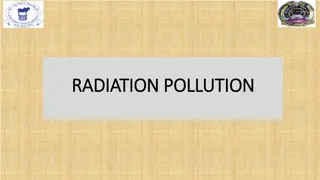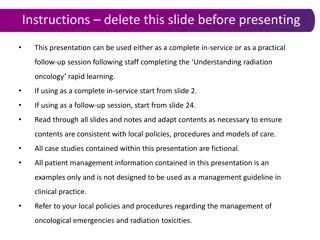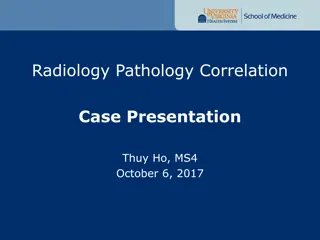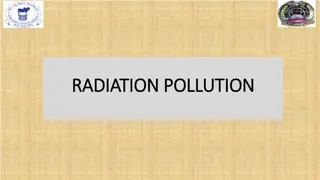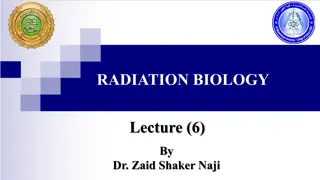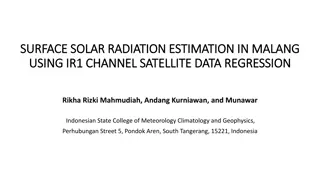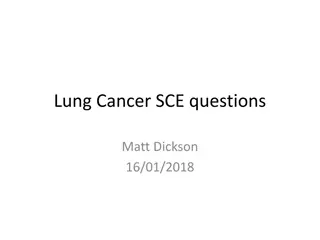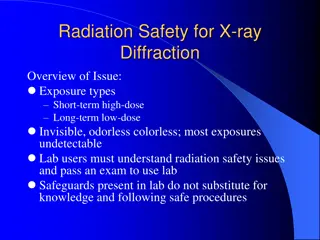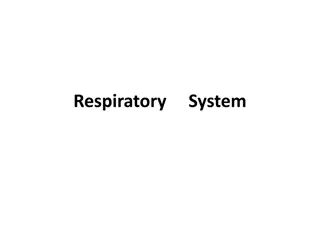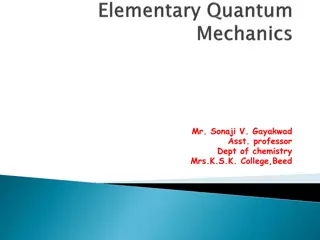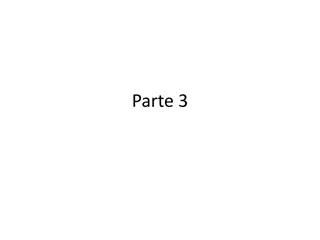Comprehensive IGRT Lung Module for Radiation Therapy Education
Improve your understanding of Image-Guided Radiation Therapy (IGRT) with this comprehensive lung module. Discover the importance of accurate targeting for lung cancer treatment, learn about cross-sectional anatomy, explore regions of interest, and understand machine parameters for Varian and Elekta systems. Dive into the world of kV and CBCT imaging techniques specific to lung treatments and enhance your knowledge in delivering precise radiation therapy.
Download Presentation

Please find below an Image/Link to download the presentation.
The content on the website is provided AS IS for your information and personal use only. It may not be sold, licensed, or shared on other websites without obtaining consent from the author. Download presentation by click this link. If you encounter any issues during the download, it is possible that the publisher has removed the file from their server.
E N D
Presentation Transcript
Appendix C Lung Module
Disclaimer This learning module was created as starting point for each cancer centre to implement as part of IGRT Education in their radiation department. The material included may not be suitable in every clinical environment. This module is designed to be adjusted to include your centre s site specific policies and procedures. This material was developed by members of the Radiation Therapy Community of Practice IGRT Education Group.
Introduction IGRT is a method used on the treatment units to improve the delivery of radiation treatment (Conventional, IMRT and VMAT plans) Allows better targeting of the tumor location while avoiding nearby healthy tissue immediately prior to radiation treatment each day
Cross Sectional Anatomy Left lung Right lung Trachea Carina Esophagus Spinal cord Aorta Inferior Vena Cava Superior Vena Cava Right and left atrium Right and left ventricles Ribs T1-T12 Clavicles Body of sternum Xiphoid process Brachial Plexus Diaphragm Thoracic Lymph Nodes
Region of Interest Lung Contralateral lung Spinal canal/cord Heart Esophagus Carina Sternum Ribs Thoracic Lymph Nodes Brachial Plexus
Machine Parameters Varian kV imaging CBCT Elekta kV imaging CBCT
Machine Parameters - Varian KV/KV matching Orthogonal images taken using KV imager CBCT matching Full Scan vs Half Scan, using KV source & detector Bowtie Filter The type of imaging used for lung is centre specific, usually daily KVs or daily CBCT. MV imaging would most likely only be used if no other imaging modality is available
kV Imaging-Varian Depending on the centre, a possible option is daily orthogonals with or without a weekly CBCT 2D/2D matching can be done using the dynamic or optimized filter to best view the anatomy Matching to bony anatomy
CBCT Imaging- Varian Depending on the centre, a possible option is daily CBCT or a weekly CBCT combined with kVs 3D matching is used, a half fan or full fan can be used depending on what anatomy needs to be visualized Matching to bony anatomy and soft tissue (centre-specific)
CBCT Imaging Parameters-Varian There are 2 types of scans and filters: Full scan: 360 with half bowtie filter (gantry starts at 178 or 182 , creates a smaller field of view, kV imaging panel is central Half scan: 200 with full bowtiefilter(gantry starts at 22 or 182 ), creates a larger field of view, kV panel is offset 14.8 cm laterally Half Bowtie Filter Full Bowtie Filter
CBCT Imaging Parameters- Varian The type of CBCT scan used will vary from centre to centre depending on the anatomy that needs to be visualized. A full scan of the thorax will produce better visualization of any peripheral structures, while a half scan captures a smaller, central area of interest and has a ring artifact peripherally Half scan, full bowtie: Prostate, note the ring artifact caused by the steep dose gradient from the x-ray beam is going through two areas on the filter Full scan, half bowtie: Lung, able to visualize the peripheral PTV (red) and spinal canal (pink)
CBCT Imaging Parameters-Varian One of the available CBCT presets can be used for the CBCT scan Low-Dose Thorax is a possible option: half filter full 360 scan dose of 0.47cGy/scan slice thickness centre-specific Depending on the centre, a manual or automatic match (usually to the spine) with a clipbox can be done
A clip box can be used for an automatic match to outline the area of interest that will be matched. The settings for the clipbox will be centre specific. This example is an auto-match to the spine, setting the clipbox around the spine in all three dimensions.
Machine Parameters- Elekta kV/kV matching Orthogonal images taken using kV imager CBCT matching Full Scan vs. half Scan, using kV source & detector Various filters and collimators can be used. The type of imaging used for lung is centre specific usually daily kVs or daily CBCT. MV imaging would most likely only be used if no other imaging modality is available
kV Imaging-Elekta Depending on the centre, a possible option is daily orthogonal images with or without a weekly CBCT 2D/2D matching can be done using template matching with iView software Matching to bony anatomy
CBCT Imaging- Elekta Daily CBCT imaging is the preferred option, allowing for soft tissue visualization and daily verification of patient positioning Full scans allow for improved image quality. Scans can be sped up (1 minute vs. 2 minutes) to reduce dose to patient and time required to scan patient Matching to bony anatomy and soft tissue (centre-specific)
CBCT Imaging Parameters-Elekta Filters F0: no filter F1: bowtie filter (decreases dose to patient) Centre-specific
CBCT Imaging Parameters-Elekta Collimators: determine the Field of View (FOV) and axial field length to be scanned FOV: small (S), medium (M), large (L) Panel positioning depends on FOV chosen Lengths: machine specific: 10, 15 or 20 represent lengths of 10cm, 15cm, 20cm
CBCT Imaging Parameters-Elekta XVI requires users to create a 1) Clipbox: to define the 3D volume to be registered. This can be around the spine or another area of interest. 2) Correction reference point 3) Alignment method: Bone or Grey Value
Matching Considerations Organs at Risk - Lung, Esophagus, Spinal canal/cord, heart, brachial plexus Priorities and Special Considerations (center/case-specific) - Bony match to spine (CBCT or kV) - Soft tissue match (CBCT) - Isodose lines (i.e. 4500cGy isodose line > 3mm away from the spinal canal)
Matching Considerations CBCT matching: soft tissue and or bony match Auto or manual match to spine or soft tissue can be done Window levels can be set to bone or lung depending on what needs to be visualized An auto match can also measure the rotation of the patient which can be useful when matching Isodose lines can be visualized to check proximity to OARs Contours can be visualized on CBCT (i.e. to ensure the target is within the PTV contour) Any changes to the target volume can be seen and reported The color blend overlay is an excellent matching tool to assess for changes
Examples: Matching to soft tissue: Auto-match with clipbox placed around soft tissue in all dimensions Important to verify all auto-matches have been done correctly
Examples: Bony match to spine: After matching to the spine, an option is to ensure the soft tissue target is within PTV Important to verify you are at the correct level in the sup/inf direction as many of the vertebral bodies can look similar, this can be verified by the carina Manual bony match to the spine using the moving window tool
Assessing the carina using the split window tool to verify the superior/inferior level to ensure image registration is correct
Matching Considerations kV image matching: bony match only A bony match to the spine can be performed if CBCT is not an option Vertebral bodies and intervertebral spaces can be used to assess the matchy superiorly and inferiorly, anteriorly and posteriorly Pedicles and spinous processes can be used to assess the match laterally
Trouble Shooting Common issues when imaging lung patients: Patient rotation Soft tissue mass is outside of the PTV Change in lung volume Automatch errors and correcting the clipbox
Patient Rotation Rotations can be seen in the green/purple setting as solid green or solid purple Centers must determine rotation tolerances, if these tolerances are reached patients must be re- positioned and another CBCT scan completed. Rotations can affect PTV coverage and dose to critical structures This example shows a different neck position and hip position
Rotation and Tumour Growth This case demonstrates rotation in the spine throughout the volume The tumour had grown (seen by the solid green) and was accompanied by some collapse This patient required a new plan due to inadequate PTV coverage.
Mass Outside of PTV Mass is encompassed by PTV on CT from CT Sim
Mass is now outside of PTV on daily CBCT Suggested course of action: Centre-specific Radiation oncologist notified
Change in Lung Volume CT Sim, CTV shown in blue Lung volume changed significantly from CT Sim to day 1 CBCT Day 1 CBCT
Change in Lung Volume Suggested course of action: Centre-specific For this specific case the radiation oncologist was notified and treatment was not given, the radiation oncologist concluded that the tumour grew and the lung partially collapsed.




